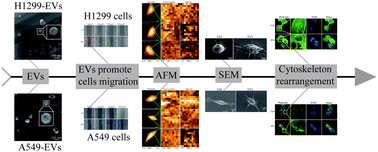Study of NSCLC cell migration promoted by NSCLC-derived extracellular vesicle using atomic force microscopy
Abstract
Extracellular vesicles (EVs) secreted by cancer cells play a key role in the cancer microenvironment and progression. Previous studies have mainly focused on molecular functions, cellular components and biological processes using chemical and biological methods. However, whether the mechanical properties of cancer cells change due to EVs remains poorly understood. This work studies the effects of mechanical changes in non-small cell lung cancer (NSCLC) cells after treatment with EVs on migration by atomic force microscopy (AFM). Different concentrations of EVs were added into the experimental groups based on co-culture experiments, while the control group was cultured without EVs for 48 h. Cellular migration was evaluated by wound healing experiments. The cellular morphology, cell stiffness and surface adhesion were investigated by AFM. Cytoskeleton changes were detected by fluorescence staining assay. By comparison to the control group, the cell migration was enhanced. After treatment with EVs, the cell length and height show an upward trend, and the adhesion force and Young's modulus show a downward trend, and filopodia were also detected in the cells. Overall, the EVs promoted the migration of NSCLC cells by regulating cells' physical properties and skeletal rearrangement.



 Please wait while we load your content...
Please wait while we load your content...